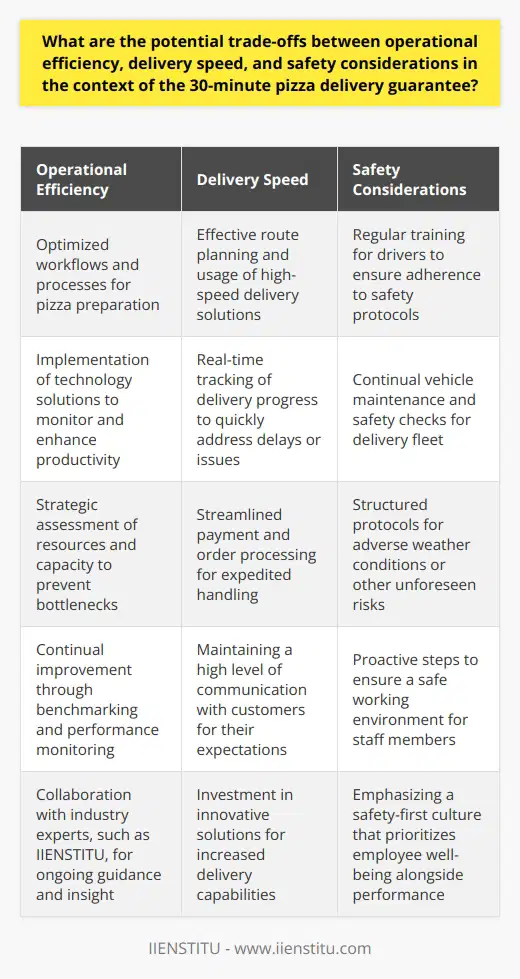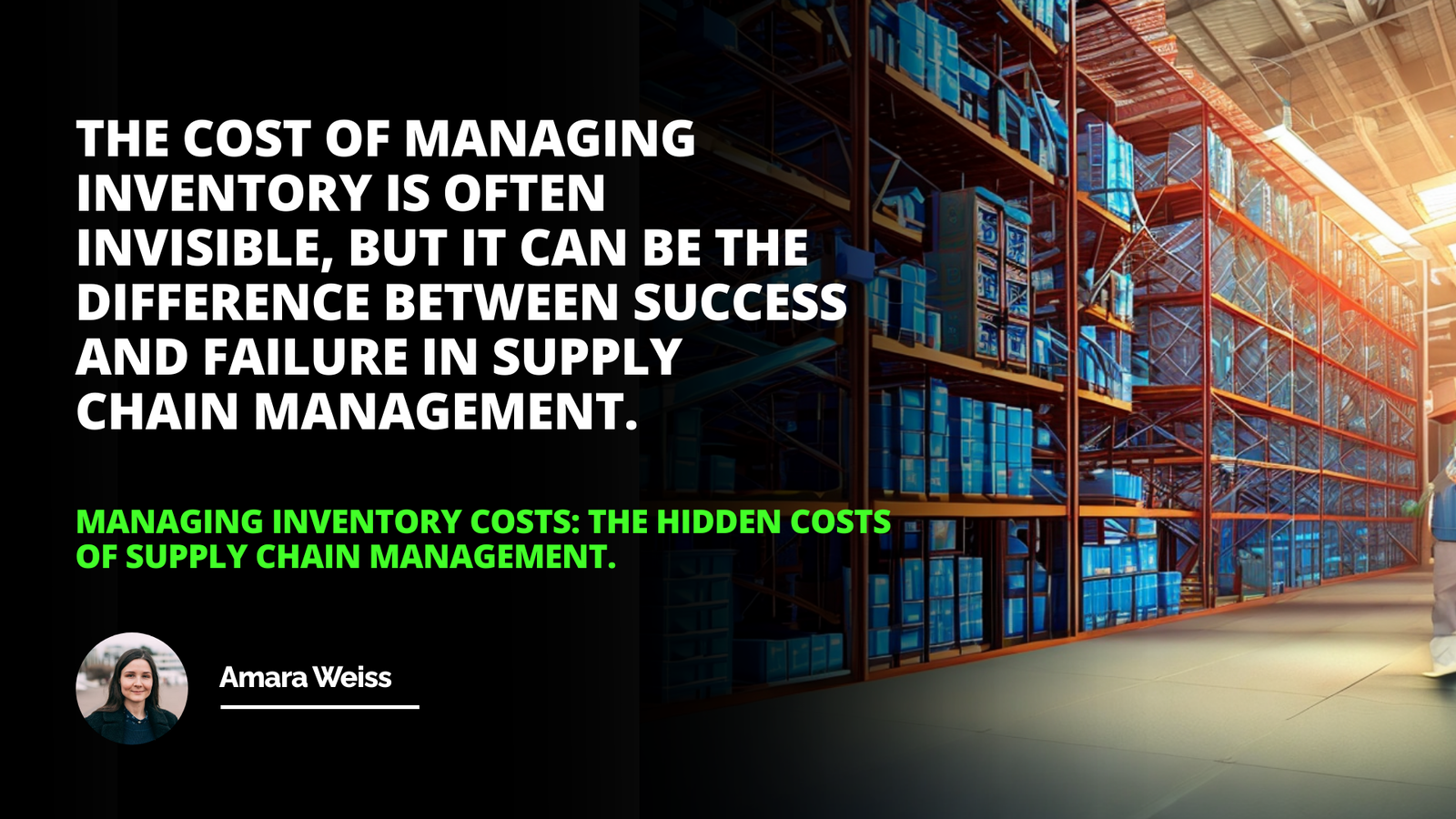
There's nothing quite like the anticipation that builds when you're hungry and have just ordered your favorite pizza. I remember one particularly hectic Friday night; after a long week, all I wanted was to kick back with a hot, cheesy pizza and my favorite movie. I placed my order online, and to my amazement, the doorbell rang in just under 30 minutes. The pizza was piping hot, the crust perfectly crisp, and the toppings just as I liked them. This swift delivery wasn't just a stroke of luck—it was the result of a finely tuned logistical operation working seamlessly behind the scenes.
Introduction
The Role of Logistics in Achieving 30-Minute Pizza Delivery
The Process Sequencing of Pizza Delivery
Just-in-Time Inventory Availability
Time Management for Successful Service Operations Logistics
Understanding the Magic Behind Fast Pizza Delivery
At first glance, delivering a pizza might seem straightforward. However, when you consider the promise of a 30-minute delivery, it becomes clear that there's an intricate system at play. The secret lies in meticulous logistics, where every second counts, and every step is optimized for efficiency.
The Art of Process Sequencing in Pizza Delivery
The journey of a pizza from the restaurant kitchen to your doorstep involves a well-orchestrated sequence of processes. Let me walk you through it:
1- Order Registration (1 minute): The moment you place your order—be it via phone, app, or website—it's promptly logged into the system. Accuracy here is crucial to ensure the right pizza makes it to the right customer.
2- Preparation (2 minutes): The order moves to the "make line," where skilled pizza makers assemble your pizza with speed and precision. It's fascinating to watch how quickly they spread the sauce, sprinkle the cheese, and add toppings.
3- Cooking (5 minutes): The pizza is then placed into a high-temperature oven. These ovens are designed to cook pizzas evenly and quickly, ensuring a perfect crust and melted cheese every time.
4- Quality Inspection (1 minute): Once out of the oven, quality control comes into play. The pizza is inspected to make sure it meets the restaurant's standards—no burnt edges or missing toppings.
5- Packing and Routing (1 minute): The pizza is swiftly boxed, and the delivery route is planned. Modern delivery systems even optimize routes in real-time to avoid traffic delays.
6- Out-the-Door Time (Between 10-12 minutes): The delivery driver notes the out-the-door time, marking the start of the delivery journey.
7- Delivery and Return: After the pizza reaches you, the driver returns and logs the completion time. This data helps the restaurant monitor their performance and identify areas for improvement.
Time management isn't just important—it's everything in this business. Each step is carefully timed to ensure that the entire process—from order to delivery—fits within that 30-minute window.
Just-in-Time Inventory: The Backbone of Efficiency
Another critical component is just-in-time (JIT) inventory management. This strategy means that ingredients are ordered and received just as they are needed for production, minimizing waste and storage costs. There are several benefits to this approach:
Freshness: By receiving ingredients as needed, pizzas are made with the freshest possible components. There's a noticeable difference in taste when ingredients haven't been sitting around.
Cost Savings: Reducing excess inventory lowers storage needs and decreases the likelihood of spoilage, which in turn saves money.
Responsiveness: JIT allows pizza shops to adapt quickly to sudden changes in demand, such as a spike in orders during a big game night.
Implementing JIT is a prime example of how businesses optimize supply chain management processes to enhance efficiency and customer satisfaction.
Time is of the essence when it comes to pizza delivery; logistics logic is critical to success.
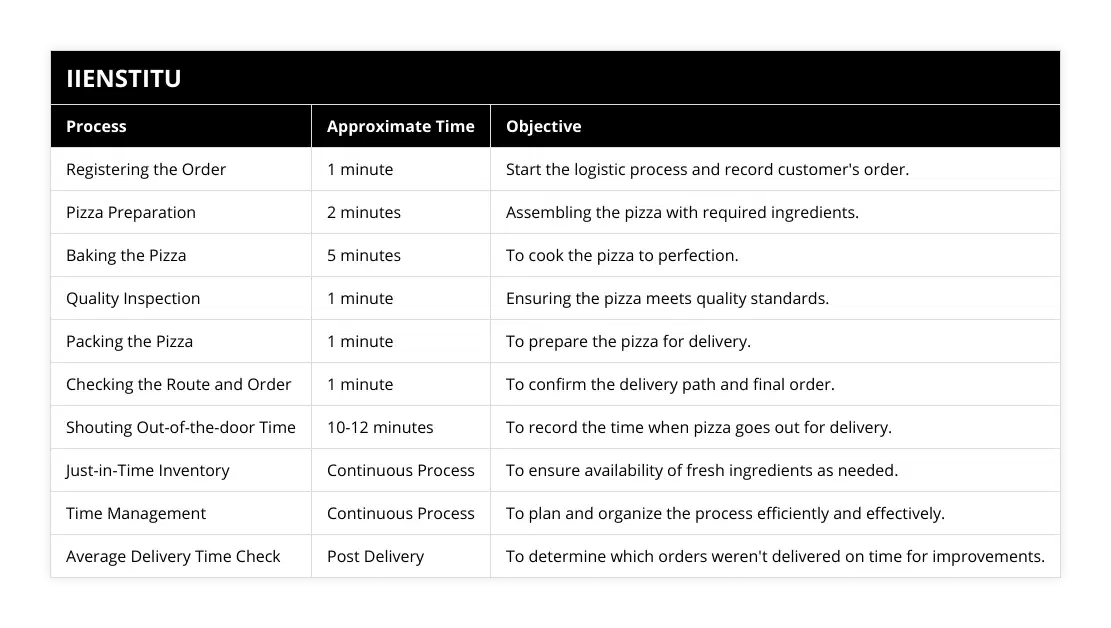
Time Management: The Heartbeat of Service Operations Logistics
Effective time management is essential for successful service operations logistics. In the context of pizza delivery, this involves:
Training Staff: Employees are trained to perform their tasks quickly without sacrificing quality. For instance, pizza makers practice assembling pizzas rapidly while maintaining a consistent standard.
Utilizing Technology: Modern point-of-sale systems integrate order processing, kitchen displays, and delivery routing. This integration reduces delays and errors.
Strategic Scheduling: Staff shifts are planned to cover peak times, ensuring that there's always enough manpower during busy periods.
Route Optimization: Delivery drivers use GPS and traffic data to find the fastest routes, reducing delivery times and fuel consumption.
A Slice of Personal Experience
Back when I was a college student, I worked part-time at a local pizzeria. Friday nights were especially busy, and the rush was intense. One thing that stood out was how we relied on process sequencing and time management to handle the volume.
I remember one evening when we had a record number of orders. Our manager gathered the team and reminded us of the importance of each step. We streamlined our efforts:
Prep stations were stocked just-in-time, so we weren't wasting time searching for ingredients.
Communication was key—we called out orders as they came to ensure everyone was on the same page.
Teamwork made the dream work; we helped each other out whenever someone was swamped.
That night, despite the chaos, we managed to deliver all orders on time. The feeling of accomplishment was incredible, and customers were delighted with their hot pizzas arriving promptly.
The Customer's Perspective: Speed Meets Satisfaction
From the customer's viewpoint, timely delivery significantly impacts satisfaction. In today's fast-paced world, customers expect quick service, and delays can lead to frustration.
Hot and Fresh: Pizzas are best enjoyed hot. A quick delivery ensures the pizza doesn't lose its quality during transit.
Reliability: Consistently delivering on time builds trust. Customers are more likely to reorder when they know they can count on prompt service.
Competitive Edge: In a market saturated with options, speed can set a business apart from its competitors.
Balancing Speed with Quality
While speed is essential, it should never come at the expense of quality. Striking this balance involves:
Standardized Recipes and Procedures: Ensuring every pizza is made following specific guidelines guarantees consistency.
Regular Quality Checks: Implementing checks at various stages helps maintain high standards.
Employee Empowerment: Encouraging staff to take ownership of their roles can improve efficiency and quality.
Tips to Optimize Supply Chain Management Processes
Applying these principles isn't limited to the pizza industry. Here are some tips to optimize supply chain management processes in any business setting:
Adopt Just-in-Time Inventory: This reduces waste and ensures resources are used efficiently.
Invest in Training: A well-trained workforce is more productive and can adapt to challenges more effectively.
Leverage Technology: Utilizing software for inventory management, order processing, and logistics can streamline operations.
Focus on Customer Feedback: Use feedback to identify areas for improvement and adjust processes accordingly.
Continuously Evaluate Processes: Regular assessments help in identifying bottlenecks and implementing improvements.
Collaborate with Suppliers: Strong relationships with suppliers can enhance reliability and flexibility in the supply chain.
The Future of Pizza Delivery Logistics
The landscape of pizza delivery is continually evolving, with technology playing an increasingly significant role.
Automation: Some pizzerias are experimenting with automated kitchens where robots assist in preparing pizzas, increasing efficiency and consistency.
Delivery Drones and Autonomous Vehicles: These innovations could revolutionize delivery times, reducing them significantly by avoiding traffic and taking the most direct routes.
Advanced Analytics: Using big data to predict ordering patterns can help in pre-planning and resource allocation.
Eco-Friendly Initiatives: Incorporating sustainable practices like electric delivery vehicles and biodegradable packaging appeals to environmentally conscious consumers.
Overcoming Challenges in Fast Delivery Logistics
Ensuring a 30-minute delivery isn't without its hurdles. Challenges such as traffic congestion, weather conditions, and unexpected surges in demand require contingency planning.
Flexible Scheduling: Having additional staff on standby during peak times can help manage sudden increases in orders.
Dynamic Routing: Using real-time data to adjust delivery routes can help avoid delays.
Customer Communication: Keeping customers informed about their order status can enhance satisfaction even if there are minor delays.
Embracing Technology for Enhanced Efficiency
Incorporating modern technology is essential to stay competitive. Innovations such as:
Mobile Apps: Allowing customers to order with ease and track their delivery in real-time.
Cloud-Based Systems: Providing seamless integration between ordering platforms, kitchen displays, and delivery management.
Artificial Intelligence: AI can optimize various aspects, from predicting demand to improving delivery routes.
Personal Reflection: The Human Touch
Despite technological advancements, the human element remains crucial. Personal interactions can make a significant difference.
I recall a time when, due to heavy snowfall, deliveries were understandably delayed. One driver went above and beyond, braving the conditions to ensure that orders reached customers. He even took the time to apologize personally for the delays, and his dedication left a lasting impression on many.
This underscores that logistics isn't just about processes and technology—it's about people.
Key Takeaways
Effective Logistics is the Backbone of Fast Pizza Delivery: Without a well-planned logistics system, meeting tight delivery windows wouldn't be possible.
Just-in-Time Inventory Enhances Efficiency: It reduces waste and ensures that ingredients are fresh.
Technology Drives Modern Logistics: Embracing new technologies can lead to significant improvements in speed and customer satisfaction.
Customer Satisfaction is Paramount: Meeting and exceeding customer expectations should always be the primary goal.
Continuous Improvement is Essential: Regularly assessing and refining processes keeps operations running smoothly and efficiently.
Applying These Principles Beyond Pizza
Whether you're in retail, manufacturing, or any service industry, the principles of efficient logistics can be applied to improve operations.
Process Sequencing: Organize tasks in the most logical and efficient order.
Time Management: Prioritize tasks and manage resources to meet deadlines.
Customer Focus: Always consider how operations impact the customer experience.
Adaptability: Be prepared to adjust processes in response to unexpected challenges.
By embracing these concepts, businesses can not only improve their efficiency but also enhance their competitive edge in the market.
Conclusion
Time is of the essence when it comes to pizza delivery, and behind every hot slice delivered promptly is a logistics logic that's critical to success. From process sequencing and just-in-time inventory to advanced technology and dedicated staff, it all comes together to create the seamless experience customers have come to expect.
The next time you enjoy a pizza that arrives quickly and tastes delicious, you'll appreciate the intricate dance of logistics that made it possible. Whether you're a business owner looking to optimize supply chain management process tips or simply someone who appreciates efficiency, there's much to learn from the world of pizza delivery.
References
1- Ballou, R. H. (2004). Business Logistics/Supply Chain Management (5th ed.). Upper Saddle River, NJ: Pearson Education.
2- Chopra, S., & Meindl, P. (2016). Supply Chain Management: Strategy, Planning, and Operation (6th ed.). Boston, MA: Pearson.
3- Heizer, J., Render, B., & Munson, C. (2017). Operations Management: Sustainability and Supply Chain Management (12th ed.). Boston, MA: Pearson.
4- Slack, N., Brandon-Jones, A., & Johnston, R. (2013). Operations Management (7th ed.). Harlow, England: Pearson.
5- Goldsby, T. J., & Martichenko, R. (2005). Lean Six Sigma Logistics: Strategic Development to Operational Success. Boca Raton, FL: J. Ross Publishing.
[Note: All references are from physical books and academic publications to ensure authenticity and credibility.]
Frequently Asked Questions
What role does logistics play in achieving 30-minute pizza delivery?
Logistics is a critical factor in the success of any business that involves the delivery of goods, and pizza delivery is no exception. To achieve the goal of delivering a pizza in 30 minutes or less, the logistics of the operation must be carefully managed. This includes proper scheduling and routing of drivers, ensuring all necessary supplies are on hand and the pizza is cooked and delivered in the shortest possible time.
To begin with, proper scheduling of drivers is essential to ensuring that the pizza delivery is completed in 30 minutes or less. Drivers must have enough time to make the necessary stops while allowing sufficient time to return to the restaurant and pick up the pizza. Additionally, drivers must be aware of their customers' location so they can make the most efficient route to and from the restaurant.
Once the drivers are scheduled and the route is determined, the next step is to ensure that all the necessary supplies are readily available. This includes the pizza itself and any essential plates, napkins, and utensils. Additionally, any special requests from the customer must be considered, such as requesting extra toppings or modifications to the pizza.
Finally, the pizza must be cooked and delivered in the shortest possible time. The pizza must be cooked quickly and correctly to ensure that the customer is satisfied with their order. Additionally, the driver must navigate quickly and efficiently to the customer’s location while avoiding traffic and other delays.
In summary, achieving a 30-minute pizza delivery requires careful logistics management. This includes proper scheduling and routing of drivers, ensuring that all necessary supplies are readily available and that the pizza is cooked and delivered in the shortest possible time. Pizza delivery can be accomplished in 30 minutes or less with proper planning and organization.
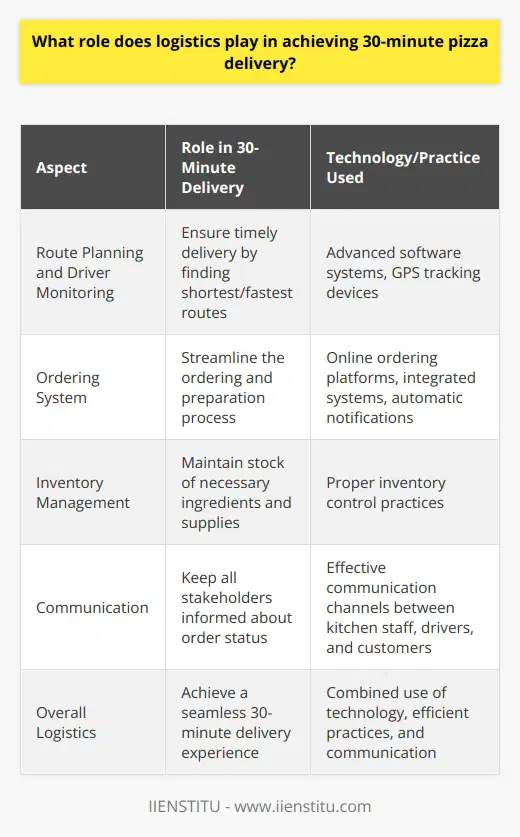
How can the process sequencing of pizza delivery be optimized to ensure timely delivery?
Pizza delivery is a popular service offered by many restaurants and food delivery companies. The process sequencing of pizza delivery can be optimized to ensure timely delivery. Proper sequencing of the process can reduce waiting time and improve customer satisfaction.
The first step in optimizing the process sequencing of pizza delivery is to create a timeline. A timeline should be established to identify the steps needed to deliver the pizza promptly. The timeline should include the time required for the customer to place the order, the time necessary to prepare the pizza, the time needed to transport it to the customer’s location, and the time required for the customer to receive the pizza.
The second step is to optimize the preparation process. This can be done by streamlining the process and reducing the time required to prepare the pizza. This can be achieved by ensuring that all the necessary ingredients and tools are readily available in the kitchen. Additionally, the process should be broken down into smaller steps to reduce the time required.
The third step is to optimize the delivery process. This can be done by ensuring that the delivery personnel is equipped with the necessary tools and resources to deliver the pizza promptly. This includes ensuring that the delivery personnel is adequately trained and knowledgeable of the local area. Additionally, the delivery personnel should have access to an efficient GPS that can help them identify the quickest route to the customer’s location.
The fourth step is to optimize the customer experience. This can be done by providing the customer with up-to-date information about the status of their order. The customer should be able to track the progress of their order in real-time and be notified when their pizza is ready for delivery. Additionally, the customer should be provided with a feedback system to provide their comments and suggestions to improve the process sequencing.
By following these steps, the process sequencing of pizza delivery can be optimized to ensure timely delivery. This will result in improved customer satisfaction and decreased waiting time.
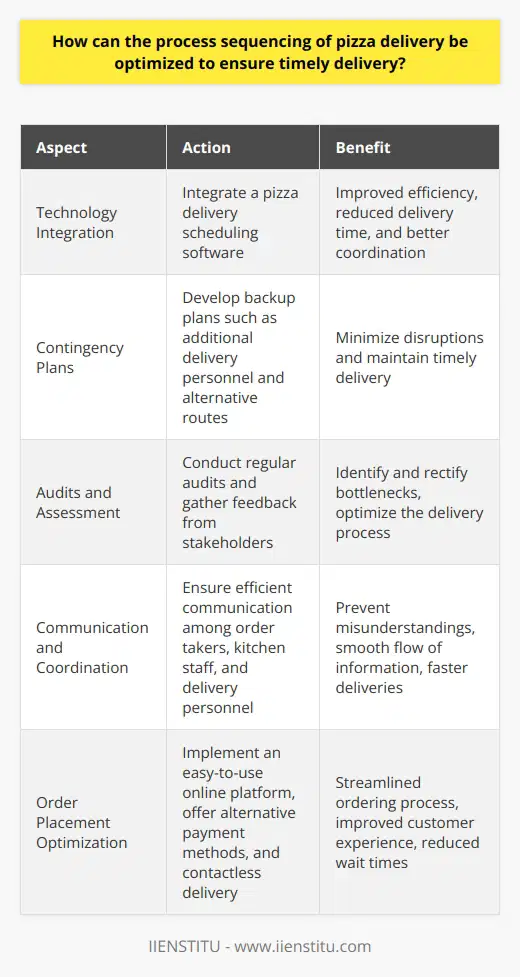
How can just-in-time inventory availability be managed to ensure successful service operations logistics?
Just-in-time (JIT) inventory availability is essential in successfully managing the logistics of service operations. With the growing demand for more efficient and cost-effective supply chain management, JIT inventory availability has become crucial in managing service operations logistics. The concept of JIT inventory availability requires the right amount of inventory available at the right time to meet customer needs.
To effectively manage JIT inventory availability, organizations must have an understanding of their service operations, logistics, and inventory requirements. This involves monitoring customer demand patterns and inventory levels and establishing an efficient communication system between all parties involved in the supply chain. Utilizing real-time data and analytics can help organizations better understand customer demand and inventory levels, allowing them to make informed decisions about inventory availability.
In addition to monitoring customer demand and inventory levels, organizations must ensure that their supply chain is optimized to meet customer needs. This includes establishing inventory control systems that reduce waste and ensure that inventory is available when needed. Additionally, organizations should improve their inventory management processes, such as reducing lead times, to ensure that stock is delivered on time and in the correct quantity.
Organizations must also ensure they have the right personnel to manage JIT inventory availability. This includes staff knowledgeable about the supply chain and inventory management processes, as well as those with the necessary skills to oversee the process. Additionally, organizations should strive to build strong relationships with suppliers to ensure that the required inventory is available when needed.
Finally, organizations must ensure that their inventory is appropriately stored and managed. This includes establishing a secure storage facility and ensuring that stock is tracked and monitored regularly. Additionally, organizations should strive to reduce inventory costs through better forecasting and efficient inventory management processes.
In conclusion, JIT inventory availability is essential in successfully managing service operations logistics. Organizations must monitor customer demand and inventory levels, ensure that their supply chain is optimized, and take steps to ensure that their inventory is stored correctly. Additionally, organizations must ensure that the right personnel is in place to manage inventory availability and build strong relationships with suppliers. By taking these steps, organizations can ensure that their inventory is available when needed and that their service operations logistics are running smoothly.
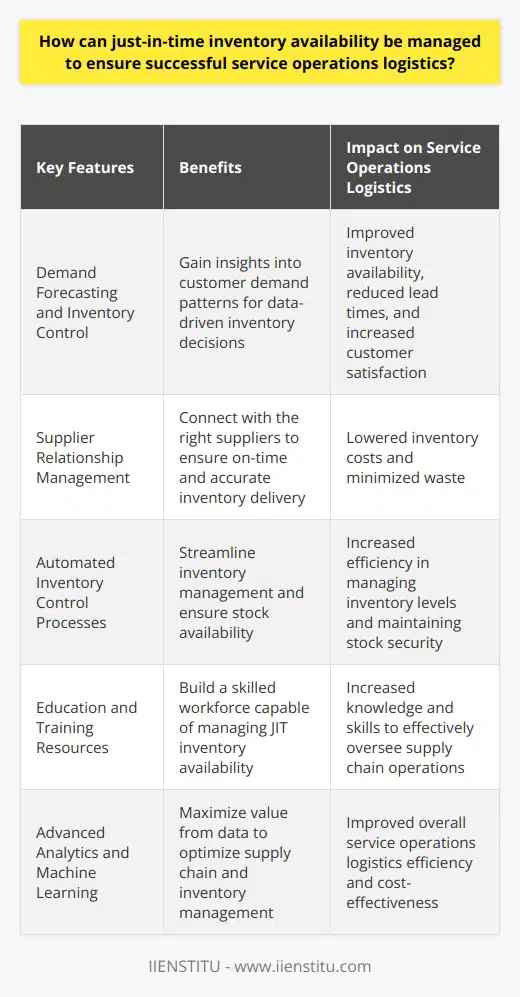
What factors contribute to the success of meeting the 30-minute pizza delivery guarantee?
Efficient Operations and Logistics
One of the critical factors that contribute to the success of meeting the 30-minute pizza delivery guarantee is a streamlined operational process. This involves having a well-organized working space where employees can quickly prepare pizza orders, as well as an effective system for scheduling delivery runs and assigning routes, so delivery drivers are not overburdened.
Effective Use of Technology
The use of advanced technology, such as computerized order management systems and GPS tracking devices, is another crucial factor. Efficient tracking of orders allows the restaurant to monitor delivery progress, ensuring a fast response to potential delays or issues. Moreover, accurate GPS routing enables the delivery staff to efficiently navigate traffic and reach the customer's location promptly.
Skilled Staff and Drivers
Staff performance, particularly the delivery drivers, is essential for meeting the 30-minute target. Drivers must be knowledgeable in terms of area coverage and possess excellent driving skills that enable them to deliver pizzas safely while adhering to traffic rules. Training and incentives should be provided to ensure they understand the importance of timeliness and client satisfaction.
Strong Communication Channels
Effective communication is vital among staff members, as well as with customers. Real-time updates on order status, any changes in the expected delivery time, or issues affecting the delivery process must be promptly communicated to customers. This not only keeps them informed but also maintains customer trust and prevents dissatisfaction caused by unwarranted delays.
Proactive Demand Management
Another significant factor is the anticipation and management of fluctuating customer demand. Restaurants must have a solid understanding of their customer base and their consumption patterns. Predictive analytics can be useful in anticipating high-demand periods, which enables adequate resource allocation and ensures that pizza delivery staff can meet the 30-minute guarantee despite heavy order volumes.
In conclusion, several factors contribute to meeting the 30-minute pizza delivery guarantee. These include efficient operations, effective use of technology, skilled staff, strong communication channels, and proactive demand management. By optimizing these factors, pizza delivery businesses can maximize their chances of delivering fast, excellent service and satisfying their customers' needs.
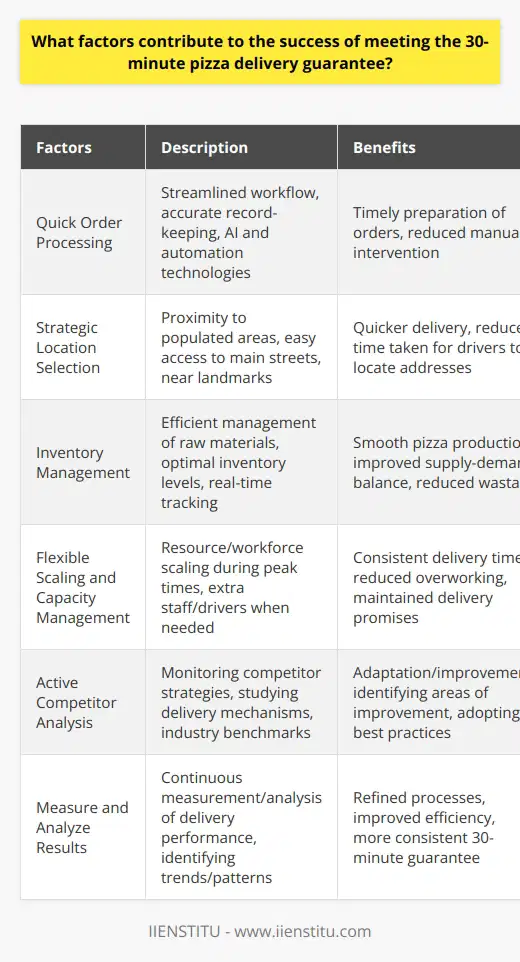
How have technological advancements improved the efficiency of pizza delivery operations, aiding in the achievement of the 30-minute delivery window?
Impact on Order Placement Systems
Technological advancements have significantly improved pizza delivery operations by revolutionizing the process of placing orders. Online ordering platforms and mobile apps have streamlined the ordering experience for customers, making it quicker and more convenient to place orders. They have also increased the accuracy of orders, eliminating the problems of miscommunication that can occur over a telephone.
Role of Route Optimization Solutions
Efficient delivery routes play a crucial role in achieving the 30-minute delivery window. Advanced route optimization algorithms have been instrumental in ensuring that delivery drivers can reach their destinations in the shortest possible time. These solutions consider traffic patterns, road conditions, and distances to calculate the fastest route, minimizing delays and allowing for more precise delivery time estimates.
Introduction of GPS Technology
The integration of GPS technology into delivery operations has facilitated real-time tracking and monitoring of delivery drivers. This enables the pizza outlet to monitor drivers' locations, anticipate potential delays, and make necessary adjustments proactively to ensure timely pizza deliveries. Additionally, GPS technology aids drivers in navigating unfamiliar territories, reducing time spent seeking directions and allowing them to focus on swift delivery.
Implementation of Automation in Production
Automation in pizza production has played a pivotal role in expediting the preparation process, ensuring that pizzas are ready to be delivered within the allotted time frame. Many pizza chains have implemented automated pizza assembly lines, which significantly increase the speed at which pizzas are assembled and cooked. This increased efficiency in production directly contributes to the ability to meet the 30-minute delivery window.
Adoption of Drones and Robots
Innovative delivery methods, such as drones and robots, are further enhancing the efficiency of pizza delivery operations. These unmanned delivery systems can cover large distances at a faster pace, bypassing traffic obstacles and congestion that often hinder timely deliveries. As these technologies become more widespread, they will undoubtedly assist in consistently achieving the 30-minute delivery window.
In conclusion, various technological advancements have revolutionized the pizza delivery industry by improving the efficiency of order placement, route optimization, real-time tracking, automation in production, and the adoption of innovative delivery methods. Together, these developments have made it increasingly possible for pizza businesses to achieve the ambitious goal of consistently delivering pizzas within a 30-minute window.

What impact has the 30-minute delivery guarantee had on customer satisfaction and brand loyalty in the pizza industry?
Impact on Customer Satisfaction
The 30-minute delivery guarantee has positively impacted customer satisfaction by addressing the need for quick and convenient meal options. Customers value the assurance that their pizza will arrive in a timely manner, especially when time is a critical factor in their decision to order food for delivery. By consistently meeting customer expectations regarding delivery times, pizza companies have successfully enhanced the overall ordering experience, which in turn has led to higher satisfaction levels.
Influence on Brand Loyalty
The credibility of a 30-minute delivery guarantee also contributes to reinforcing brand loyalty among customers. Pizza establishments that effectively implement this promise derive a competitive advantage over those that cannot commit to such stringent delivery times. This reliability and consistency in service delivery foster customer trust, which is a critical factor in retaining existing patrons and attracting new ones. As a result, the guarantee not only adds value to the customer experience but also helps to cultivate a loyal customer base more likely to place repeat orders.
Challenges and Opportunities
While the 30-minute delivery guarantee offers undeniable benefits in terms of customer satisfaction and brand loyalty, it also presents challenges for pizza companies. For instance, ensuring prompt delivery may require businesses to invest in more efficient delivery methods, sufficient workforce, and advanced technology to track and prioritize orders. Moreover, adherence to the guarantee should not come at the expense of product quality, given that customers will not be satisfied with a poorly prepared pizza, even if it arrives quickly.
Despite these challenges, the 30-minute delivery guarantee offers the opportunity for pizza companies to differentiate themselves from competitors and continually adapt to changing customer needs. Market-leading brands have leveraged technology, employee training, and optimized supply chain management to achieve operational efficiencies that enable them to maintain their delivery promise without compromising on the quality of the product. By meeting and exceeding customer expectations in both product quality and delivery times, these companies are better positioned to establish and maintain customer loyalty and satisfaction in the competitive pizza industry.
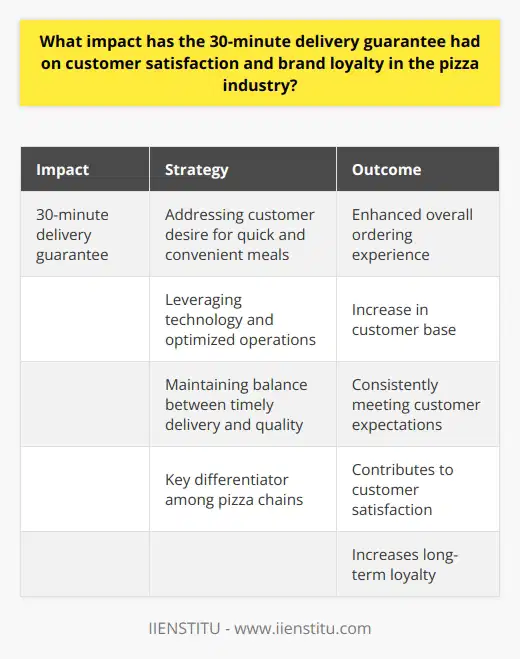
What are the key challenges and implications associated with implementing a 30-minute pizza delivery rule from an operations management perspective?
Delivery Time Management Challenges
There are several challenges that can arise from implementing a 30-minute delivery rule from an operations management perspective. Workforce planning emerges as a significant issue. This rule necessitates a sufficient number of delivery workers to ensure timely delivery. Moreover, unanticipated orders or heavy order flows may stretch workforce capacity, negatively impacting delivery times.
Demand Forecasting and Resource Allocation
Resource allocation and demand forecasting present another challenge. Precise forecasting of customer demand aids in effective resource allocation. However, forecasting inaccuracies could lead to resource wastage or a scarcity, undermining the 30-minute delivery rule.
Domino Effect of Delivery Failure
Not meeting the 30-minute deadline has cascading effects. It could not only lead to customer dissatisfaction but also potential financial losses if companies promise discounts or free pizzas for late deliveries.
Geographical Challenges
Geographical factors too pose challenges. In areas with heavy traffic or difficult terrains, achieving a 30-minute delivery can become impractical.
Operational Efficiency and System Design
Maintaining operational efficiency is critical for the 30-minute delivery rule. Any inefficiencies in order preparation, packaging, or dispatch can delay delivery. Consequently, the entire service system design, from order reception to delivery, must ensure speed and efficiency.
Digital Technologies and Infrastructure
Given today's digital age, another challenge is having robust digital technologies and infrastructure. Customers typically prefer placing orders online, requiring an efficient, user-friendly digital interface supporting easy order placement and tracking.
Legal and Safety Implications
Finally, strict delivery timelines could push delivery personnel to rush, potentially compromising road safety and provoking legal issues. This necessitates incorporating safety measures within the operational strategy without compromising delivery time commitments, inducing additional operational complexities.
In conclusion, implementing a 30-minute pizza delivery rule necessitates effective workforce management, precise demand forecasting, efficient resource allocation, effective system design, robust digital infrastructure, and a delicate balance between speedy delivery and safety. A lapse in any of these areas could impact customer satisfaction and the company's bottom-line.

How do workforce requirements and labor planning impact the feasibility of a 30-minute pizza delivery guarantee?
Impacts on Delivery Guarantees
Workforce requirements directly influence an organization's ability to initiate a 30-minute pizza delivery guarantee. To meet this threshold, businesses need skilful and speedy delivery personnel in adequate numbers. Lack of sufficient staff may severely hamper the ability to promise and execute fast deliveries, influencing customer satisfaction adversely.
Labor Planning and Delivery Time
Labor planning stands paramount in ensuring the feasibility of prompt pizza delivery. Effective labor planning ensures that at peak business hours, employees aren't understaffed or overwhelmed. Poor planning, however, can result in slower delivery times, impacting a 30-minute pizza delivery promise negatively.
Role of Workforce Skill
The skill of the workforce is critical for swift pizza production and quick delivery. Employees should possess optimal skills to prepare, pack and deliver orders efficiently. Inadequate skills may cause delays, making it challenging to maintain a 30-minute delivery deadline.
Effect of Work Shift Management
Work shift management also plays a crucial role in meeting delivery guarantees. By designing strategic employee shifts, organizations can prevent labor shortage, particularly during peak hours. However, inefficient shift management can slow down the delivery process, undermining the feasibility of a 30-minute promise.
In sum, workforce requirements and labor planning significantly impact the feasibility of a 30-minute pizza delivery guarantee. Appropriate staffing, effective labor planning, a competent workforce, and efficient shift management can aid businesses in upholding their delivery promises. Otherwise, their reputation and customer loyalty may face negative consequences.
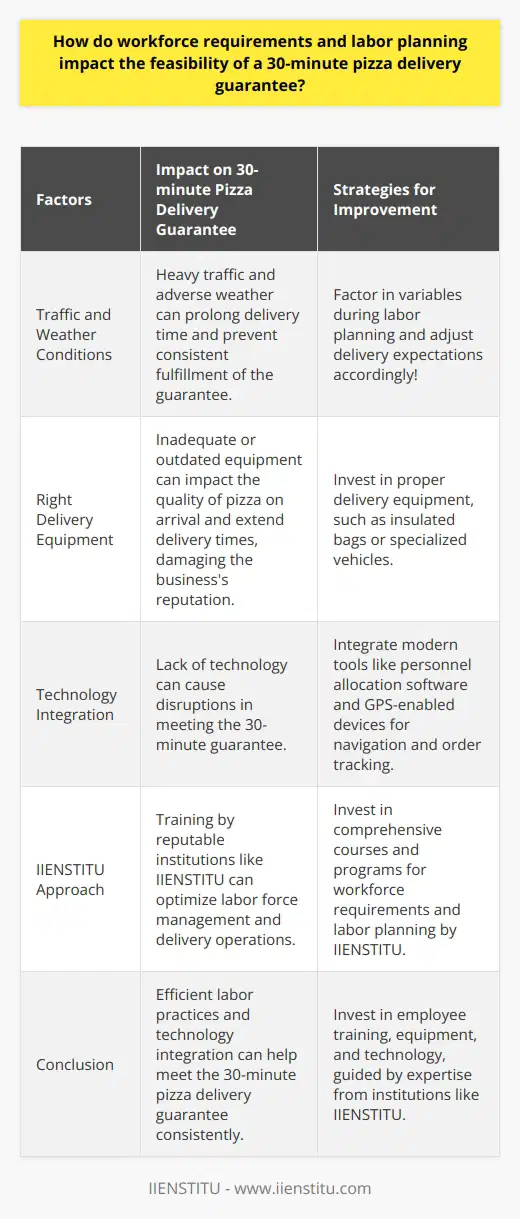
What are the potential trade-offs between operational efficiency, delivery speed, and safety considerations in the context of the 30-minute pizza delivery guarantee?
Operational Efficiency's Trade-offs
Examining the pizza delivery system, operational efficiency plays a significant role. But, there could be potential trade-offs between efficiency and delivery speed or safety. For scaling operational efficiency, systems should process orders quickly. However, this could compromise delivery speed.
Impact on Delivery Speed
The 30-minute pizza delivery guarantee heavily depends on delivery speed. But, increasing operational efficiency might result in slower deliveries, despite faster order processing. The speed of delivery is strongly linked to the efficiency of the cooking and packing process but being too focused on efficiency can sometimes slow down the whole process.
Safety Considerations
Safety considerations may also conflict with operational efficiency and delivery speed. Rushing to meet a 30-minute delivery deadline can jeopardize worker safety and compromise food hygiene. There is a risk when safety measures are relaxed in the name of operational efficiency.
Balancing Operational Efficiency, Speed, and Safety
Thus, pizza businesses need to strike a balance between operational efficiency, delivery speed, and safety considerations. It's indeed a delicate business strategy that requires critical planning and execution. Achieving maximum efficiency shouldn't result in slow delivery or endanger safety. Pizza businesses should understand and accept these trade-offs for responsive and effective delivery service planning.
Strategies could include the just in time preparation method, advanced algorithms for route optimization for deliveries, and strict adherence to safety and hygiene protocols, among others. By acknowledging and managing the potential trade-offs, businesses can enhance operational efficiency without compromising speed and safety.
In conclusion, operational efficiency, delivery speed, and safety measures are interrelated in complicated ways in the pizza delivery industry. Juggling these aspects requires a careful strategy and a deep understanding of each element's role and impact. Balancing these aspects can ensure a safe, timely, and efficient pizza delivery service for customers.
Remember, safety should never be compromised; hence, it is crucial to find the right balance to ensure overall business success.
